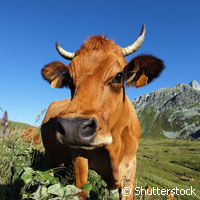Global drive to wipe out cattle plague nears finish line
Scientists are bringing down the deadly cattle plague 'rinderpest', effectively locking into place the steps required for full eradication of this viral disease. It will be only the second time in history that people have succeeded in eradicating a viral disease - after smallpox which was wiped out 30 years ago. While the disease does not affect humans directly, it adversely affects people's pockets and tummies, as farmers contend with the loss of sick cattle or other hoofed animals, and in turn with economic loss or even famine. 'The control and elimination of rinderpest has always been a priority for the Organization since its early days in its mission to defeat hunger and strengthen global food security,' United Nations' (UN) Food and Agriculture Organization (FAO) Director General Jacques Diouf said at the recent Global Rinderpest Eradication Symposium in Rome, Italy. 'The disease has affected Europe, Asia and Africa for centuries and has caused widespread famine and decimated millions of animals, both domestic and wild,' Dr Diouf pointed out. 'In the 1880s, rinderpest caused losses of up to 1 million head of cattle in Russia and central Europe.' Rinderpest emerged in Africa in the early 1900s, forcing locals to slaughter millions of heads of livestock and wildlife, which in turn led to widespread famine. Experts believe that up to 33% of the human population of Ethiopia died of starvation as a result of that pandemic alone. Africa, the Middle East and South Asia were hit with devastating rinderpest outbreaks in the early 1980s. Nigeria lost USD 2 billion (around EUR 1.42 billion) at that time. Kenya was the last country to deal with a rinderpest outbreak in 2001. The FAO and the World Health Organisation of Animal Health (OIE) will release a global rinderpest eradication announcement next spring or summer, pending a review of final official disease status reports from various countries. The main objective is to free countries and ultimately the entire world from rinderpest. A system that can verify the steps toward short and long-term aims, and offer countries the support they need, must be established. This system is called the 'OIE Pathway'. Partners of the Global Rinderpest Eradication Programme (GREP) and the African Union - Interafrican Bureau for Animal Resources (AU-IBAR) have proposed changes to the OIE Pathway to bring it in line with the new rinderpest epidemiological situation. The OIE adopted in 2007 the new Terrestrial Animal Health Code Rinderpest Chapter and Annex, which kick-started the final drive for global rinderpest eradication by 2011. The FAO has been working together with OIE, the International Atomic Energy Agency (IAEA) and donors to investigate the pattern and nature of rinderpest; to support veterinary services and farmers' efforts to recognise and control the disease; to develop and implement vaccination campaigns; and to wipe out the disease within the framework of the OIE Pathway. 'We are confident that the World Assembly of Delegates of the OIE will officially recognise all remaining countries as free from the disease in May 2011 and thus close on that day OIE Pathway activities for rinderpest eradication,' OIE Director General Bernard Vallat remarked. 'The OIE programme was launched back in 1989 and has been extremely reliable in assessing the presence or absence of the virus in all countries worldwide. It should serve future ventures in eradicating other animal diseases.' Commenting on the success of the programme, Dr Diouf said: 'It would not have been possible without the united efforts and determined commitment of the governments of all affected and exposed countries, without the AU-IBAR and the responsible regional organisations in Asia and Europe, without the donor agencies committed to this endeavour.'



